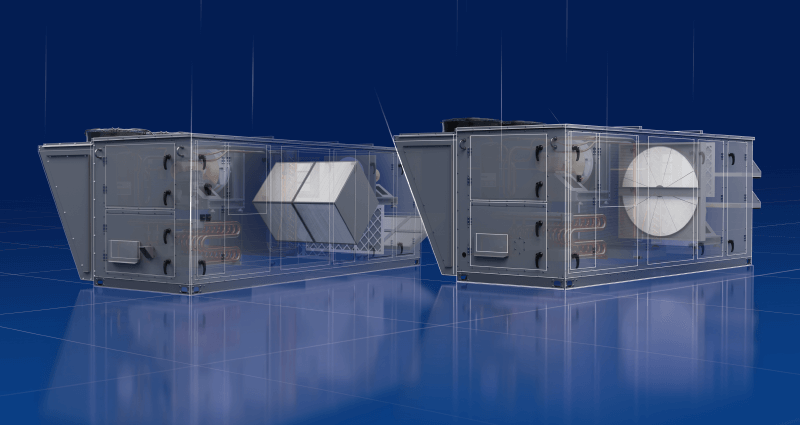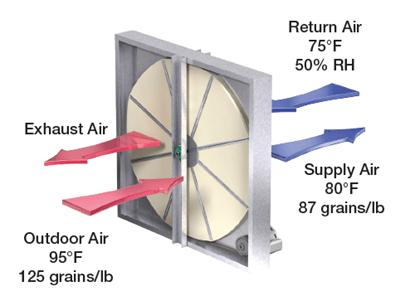HVAC Energy Recovery Technologies: Wheel versus Core

Energy recovery technology is commonly used in industrial, commercial, and institutional applications to provide comfort ventilation. Utilizing energy recovery allows for the supply airstream to be pre-conditioned by the return airstream, effectively reducing the amount of mechanical cooling or heating that is needed to condition the space. The most common energy recovery technologies on the market today are energy wheels and energy cores.
Energy Wheels
Energy wheels spin between the supply and return airstreams, effectively transferring energy from one airstream to the other as shown in Figure 1. In general, energy wheels are typically used in applications requiring high percentages of outdoor air, since energy wheels can typically handle higher airflows. There are two main types of energy wheels. First, there are polymer wheels with an embedded silica gel desiccant. The polymer material handles the sensible energy transfer, while the silica gel desiccant handles the latent energy transfer, making the polymer wheel a total enthalpy energy recovery device. Polymer energy wheels are 70-80% effective, which means that the nominal cooling capacity needed to condition the space can be reduced by 3-4 tons per 1000 cfm that is pulled through the energy wheel. Maintenance on a polymer energy wheel is simple – because the wheel is constructed of a plastic-like material, it can be washed using water and a mild detergent.
 |
| Figure 1: Energy wheel summer operation |
Next, there are aluminum wheels with a sprayed-on molecular sieve. The aluminum material handles the sensible energy transfer, and the molecular sieve handles the latent energy transfer, making the aluminum wheel a total enthalpy energy recovery device. Like polymer wheels, aluminum wheels are 70-80% effective. Aluminum wheels are often used in more industrial applications. Aluminum wheels have a smaller pore size (~4 angstrom, compared to ~22 angstrom with the polymer energy wheel). This makes them ideal for applications like bathroom exhaust. The maintenance on an aluminum energy wheel differs from that of a polymer wheel – it is typically recommended that any particulates be vacuumed off the surface of the aluminum energy wheel. It can also be purged with compressed air, or dust and particles can be wiped from the surface.
Energy Cores
Energy cores, on the other hand, are static devices that transfer energy between the supply and return airstreams as shown in Figure 2. Energy cores are typically seen in applications requiring lower airflow since energy cores can typically handle less airflow than an energy wheel. Since the energy core has no moving parts, the need for mechanical maintenance and repair is greatly reduced. Energy cores also have a lower cross leakage percentage than energy wheels. It is possible for air from the exhaust airstream to be transferred back into the supply airstream – this concept is called the exhaust air transfer ratio (EATR). Energy wheels have a typical EATR between 3-5%, whereas this number is 0-1% for energy cores.
 |
| Figure 2: Energy core summer operation |
There are two main types of energy cores. First, there are fiber energy cores. Fiber energy cores are capable of both sensible and latent energy transfer. Fiber cores are only about 50-60% effective – while this meets the minimum standards for energy recovery effectiveness set out in ASHRAE 90.1, it is less effective than an energy wheel by 20-30%. This lower effectiveness means that the nominal cooling capacity needed to condition the space can be reduced by 1-2 tons per 1000 cfm that is pulled through the energy core. In terms of maintenance, since fiber cores are made from a paper-like material, they cannot be cleaned in water. Excessive moisture can remove the enthalpic coating from the fiber energy core, causing decreased performance and other damage. Instead, any particulates can be vacuumed off the surface of the fiber core.
Next, there are polymer energy cores. Like fiber cores, polymer cores are capable of both sensible and latent energy transfer. Polymer cores have a slightly higher effectiveness than fiber cores at about 55-65%. Since polymer cores are made from a plastic-like material, they can be cleaned with water and a mild detergent.
Utilizing energy recovery allows for energy savings. The wide variety of energy recovery devices on the market enables the user to choose the best energy recovery device for their application.
Learn more about Greenheck DOAS units with energy recovery. https://www.greenheck.com/products/air-conditioning/dedicated-outdoor-air-systems
DOAS Energy Recovery
Read Next
Apply energy recovery to ventilation systems -- It's the Law!
Achieve Long-Term Indoor Air Quality with These DOAS Fundamental Features


from